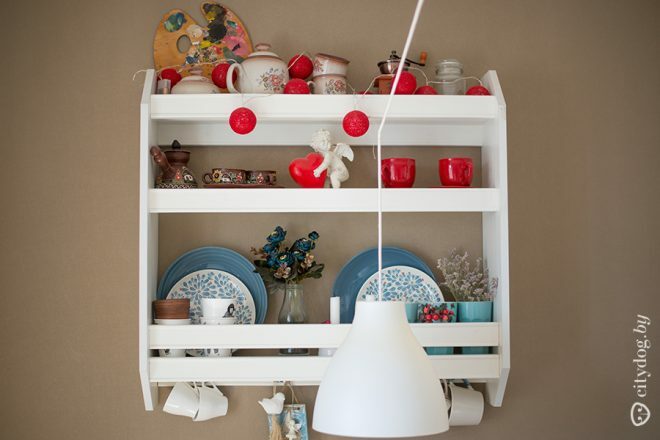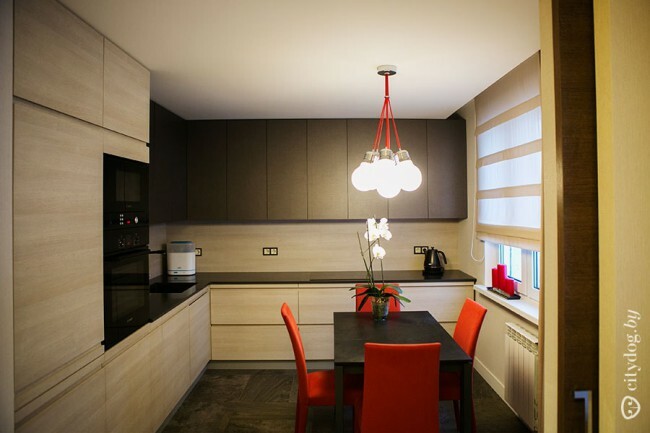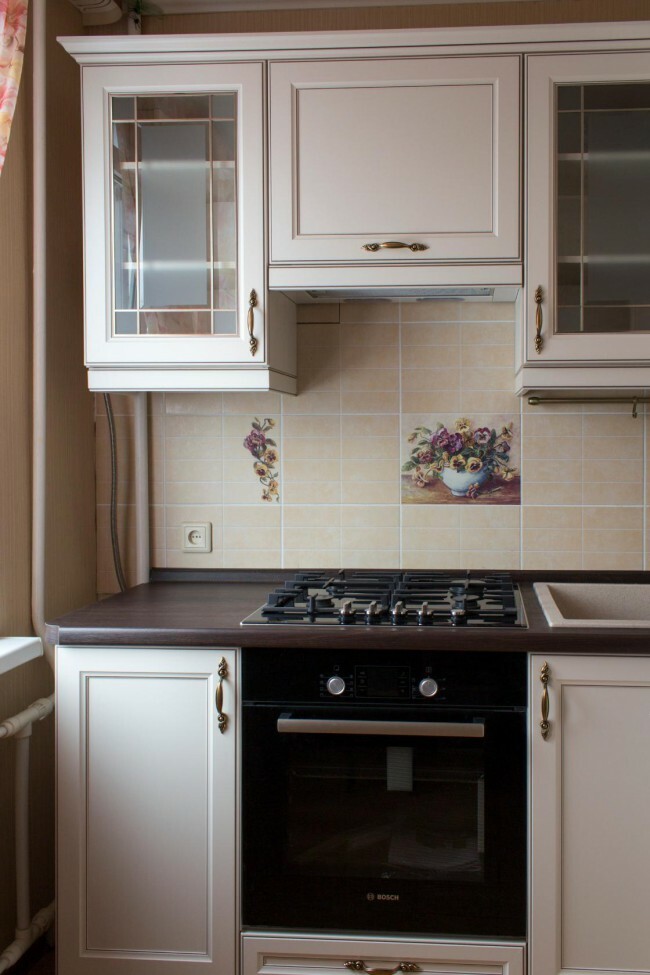How can you decorate your kitchen floor? The range of materials is increasing all the time. Manufacturers provide coatings that no one would have used in rooms with high humidity with new properties, for example, resistance to water. As a result, their popularity is growing, sometimes overtaking the demand for traditional tiles, artificial stone, and solid wood.
Many people like laminate in the kitchen. It looks beautiful, there is a large assortment of textures and colors, it is pleasant to walk on such a floor. It is important to choose a waterproof laminate, then you will not have to change it soon, regretting your choice.
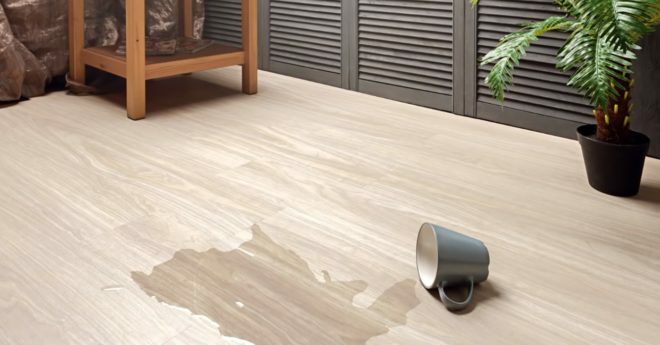
Image taken from https://www.youtube.com/watch? v = bM9p3xzEjUQ
Laminate in the kitchen: pros and cons
Like any material, laminate flooring in the kitchen has its pros and cons. First about the benefits:
Attention! Earned on our website kitchen designer. You can familiarize yourself with it and design your dream kitchen for free! May also come in handy wardrobes designer.
- Great appearance. A large selection of colors and patterns makes it easy to match it to any interior. There is an imitation of natural wood, stone, tiles.
- Compared to tiles, the MDF coating is warm and pleasant to the touch. If necessary, a warm floor is laid under it.
- Imitating the look and texture of wood, this coating is cheaper than solid wood, does not creak, and is more resistant to moisture.
- Costs less than artificial stone. Energy savings can be made as these floors are much warmer than stone floors.
- Compared to linoleum, it can withstand heavy mechanical loads and does not deform.
- The floor is easy to install and repair (sometimes it is enough to replace a few lamellas).
- Easy to wash, it does not deteriorate from exposure to detergents. Stains are rare.
- By choosing an embossed surface, you can minimize the possibility of slipping on the floor.
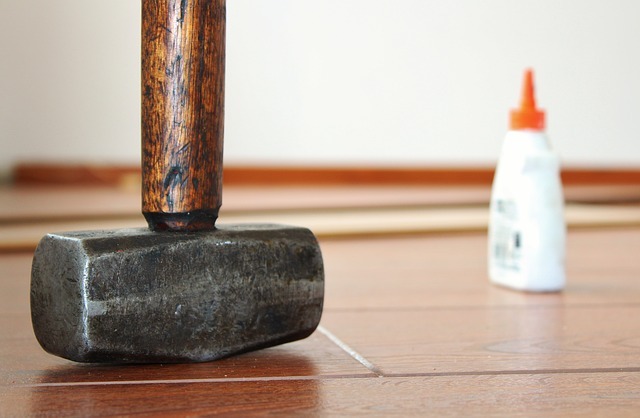
Flaws:
- Scratches easily remain on the surface.
- Only waterproof products can withstand prolonged contact with water without changing their appearance. They are more expensive than moisture resistant, and even more so standard laminate.
- The coating itself does not provide sound insulation. If there is a gap between it and the base, the sounds will even be amplified. The underlay can fix this. It dampens sounds, prevents floor creaking, evens out small distortions. There are special models in which the bottom layer is designed to attenuate sounds.
What should be the covering for the kitchen?
Laminate for the kitchen is recommended to be taken with a thickness of at least 9 mm, otherwise the lamellas will be fragile. The material must be safe for health: products marked E 0 do not emit formaldehyde into the air, E 1 - at an acceptable level. Purchase non-slip products to protect yourself from injury. It is also important to consider resistance to water, mechanical friction.
Wear resistance
The laminate class for the kitchen is 33 or 34. Then you don't have to worry about the possible flooding, in the next 15 - 20 years it won't stop.
The first number reflects resistance to mechanical stress, the second - protection from moisture. If the house is home to 1 - 2 people, great wear and tear does not threaten, you can use products of the 23rd class. If they rarely cook, but walk a lot, it is better to stay at the 32nd grade. Protecting joints with Hydrokit, Click guard will bring the resistance to water almost to the level of 33 class. Still, it's better not to economize. High-quality laminate from well-known companies will last longer and retain its original appearance after multiple episodes of contact with liquids.
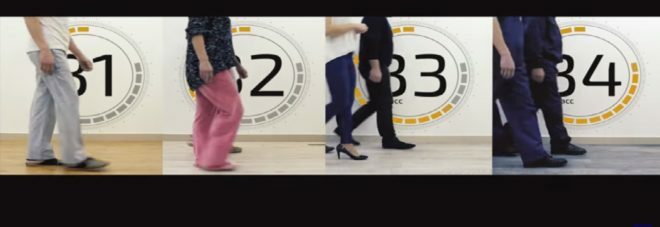
Image taken from https://www.youtube.com/watch? v = 1mAxcrvDVik
Moisture resistance
The main difficulty in the selection of materials for the kitchen is that they must withstand high humidity, and sometimes direct contact with water.
Standard laminates absorb 8 - 16% water. It is definitely not suitable for a room where food is prepared. In the absence of financial opportunities to purchase a more expensive and high-quality floor, it is impregnated with polyurethane or epoxy glue to protect it from water. They are glued without a backing and covered with polyurethane varnish on top. But even in this case, only short-term contact with water can pass without a trace, in other cases the floor will be damaged.
For the kitchen, 2 options can be considered:
- Moisture resistant laminate that absorbs 2 - 8% moisture. The basis is made up of chopped wood and cellulose with the addition of polymers. The film protects the outside of the board. The joints and the inner part are deprived of such protection; when water flows, they intensively saturate moisture. To reduce this disadvantage, the joints are treated with a wax-like material. It is necessary to wipe off the liquid immediately, the floor can withstand up to 15 - 20 minutes without damage.
- Laminate for the kitchen is waterproof, absorbing no more than 2% of water. The base is plastic. Even in the event of a flood, if it is eliminated within 6 hours, it is possible to save the floor, which will not lose its presentation.
Another way out is a combined floor: in places where the probability of water ingress is high, tiles are laid, the rest of the area is covered with laminate (for example, a dining area).
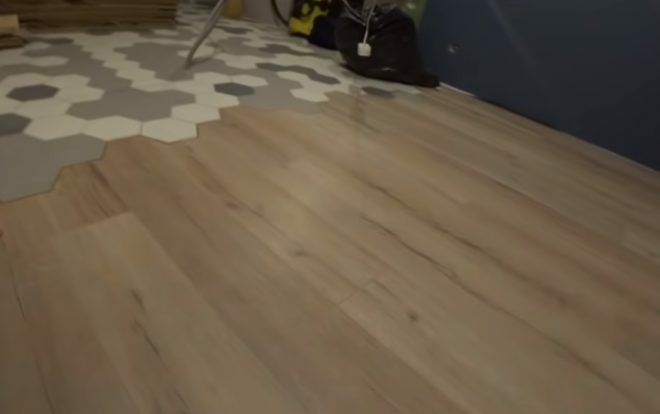
Image taken from https://www.youtube.com/watch? v = pSYlTLP4GN4
Ease of operation
Laminate is well cleaned of dirt. The main thing is not to pour water when cleaning in large quantities, do not use abrasive products. Stains are easy to remove. The surface film protects against damage by ultraviolet light, chemical agents.
Wide range of decors
The assortment of laminate flooring for sale is quite wide, it is easy to find imitation of wooden planks, decks, decking boards. The material can be single-strip (the pattern is the same in all lamellas) and multi-lane (the colors are different, there are lighter and darker lamellas, it looks more interesting and more expensive). You can find laminate flooring designed like tiles.
The most demanded size: 120 - 138 cm in length, 19 - 20 cm in width. The aspect ratio of 9: 1 is the most popular, you can choose 1: 16 and other options.
A wood grain pattern looks good in a kitchen with wooden facades of the same color, suitable for classic, modern, ecological and Scandinavian styles. Used imitation oak, pine, chestnut, ash, walnut, rare wood species. If you want a versatile floor that will look good with any furniture, you can choose a solid color floor with an almost indistinguishable pattern.
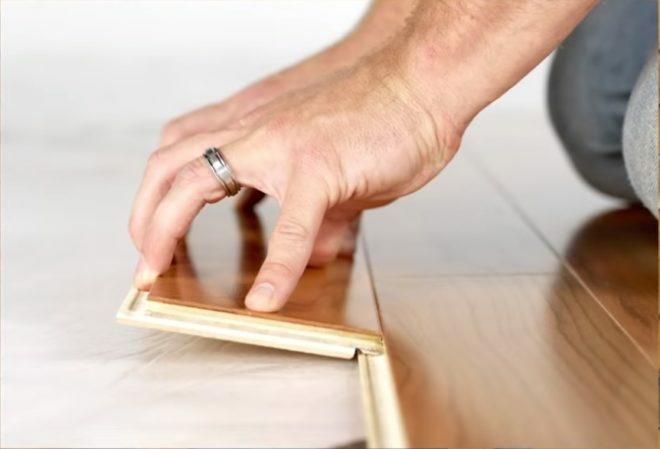
Image taken from https://www.youtube.com/watch? v = bM9p3xzEjUQ
A floor imitating stone or tile is also in demand. There is even a laminate with a concrete texture, which perfectly complements a minimalist or loft kitchen.
Types and features of laminate
Laminate in the kitchen is often chosen without a chamfer. This is a small decorative bevel of the edges, emphasizing the contours of the lamellas. But in the grooves, dust and food debris can accumulate. Therefore, for the kitchen, they make an imitation of chamfers when the surface is even, but the edges of the parts have a different shade of color. It is both beautiful and practical.

Classic HDF coverage
The basis is a high-density wood board, obtained by pressing and heating the smallest shavings of coniferous wood. In waterproof products, its density is 850 - 1050 kg / m3. (more than MDF boards). The outer film protects from sunlight, chemical factors, and reduces static charge. The pattern, color and texture are determined by the next layer - from film or paper. Produced in Russia (Kronospan, Kronostar), Germany (Egger).

Image taken from https://www.youtube.com/watch? v = bM9p3xzEjUQ
PVC cover
PVC coated laminate flooring is also called vinyl flooring. They look like rectangular stripes of standard sizes or square tiles with a side length of 30-60 cm. The waterproof laminate has a polyvinyl chloride backing. Above are the layers:
- fiberglass increases strength;
- decorative layer;
- PVC coating practically does not allow water to penetrate deep;
- polyurethane or polyester coating increases impact resistance, floors do not fade over time.
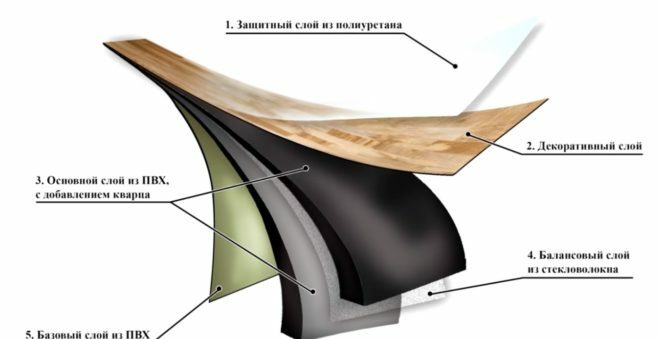
Image taken from https://www.youtube.com/watch? v = bM9p3xzEjUQ
At the bottom of some products, a sound and heat insulating and adhesive layer is added.
Installing laminate flooring in your kitchen is extremely easy. There is a laminate with a layer of glue already applied, you just need to remove the protective film. In other cases, the adhesive is applied independently. Some of the products have locks, they are laid, like a regular laminate, with a hitch. To make it fit as tightly as possible, use a mallet (a special hammer made of wood or rubber). It is desirable that the floor surface is even, otherwise you cannot do without a substrate and an additional layer of OSB slabs.
The disadvantages include the flammability of the material and the release of harmful chemicals into the air. People with respiratory problems or those prone to allergies should opt for more natural materials.
Modular coverage
Cork laminate combines the properties of a cork floor with the ease of installation of a laminate. The base is HDF board. Cork layers play a decorative and shock-absorbing role. Outside, the product is protected by PVC foil or varnish. There are glue and lock options. The floor is warm and pleasant to the touch. Since the material is quite soft, when knives fall, walking in heels, moving furniture, deformations and scratches can remain.
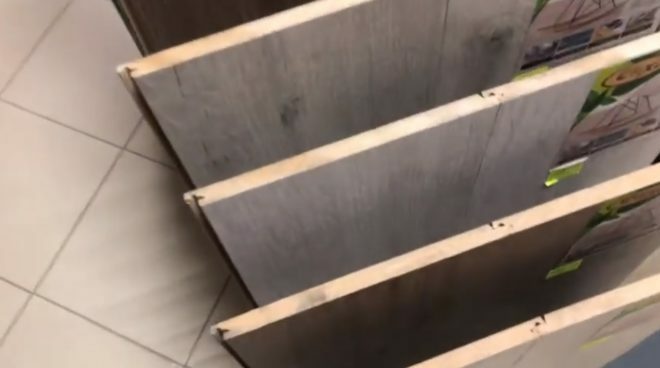
Image taken from https://www.youtube.com/watch? v = hhf_ZNkWSMM
Modular marmoleum, a modern material without synthetic components, has great resistance to mechanical stress. A thin layer of linoleum on top provides high strength and durability of the product, the cork layer - sound insulation, retains heat, the base is HDF board.
Installing a warm floor under the laminate
Is it possible to lay laminate flooring in the kitchen if you plan to install a warm floor? It depends on the specific type of building material. The manufacturer indicates on the packaging the characteristics of the product, including the thermal resistance of the product. It should not exceed 0.14 K / W. Then the wires will not overheat. Electric heating is not suitable for most types of laminate flooring, since heating occurs abruptly, in a short period of time. Overheating of the material is fraught with deformation of the floor. For smooth uniform heating, a rheostat is installed.
Water and infrared underfloor heating is more suitable for laminate flooring. The surface temperature must not be allowed to rise above 27 degrees. To prevent the lamellas from drying out, during the period when the warm floor is turned on, it is necessary to monitor the humidity of the air, maintain it at least 50%.
You will need:
- thermostat on the wall;
- film underfloor heating of different widths (from one and a half meters to optimally fill the usable area);
- underfloor heating;
- bituminous pads, scotch tape, electrical tape, terminals.
Installation of infrared film floor:
- Remove the old cover. Roll the foil backing around the entire perimeter. Secure it together with duct tape.
- Roll out the infrared film. Consider the places where you will have a wardrobe, bed, chest of drawers - you can not do insulation under them. The main thing is that all the contact terminals are on the same side, and the cut parts are insulated. Heating elements must touch the laminate and not the concrete.
- The wires are connected according to the connection diagram to the contact group and insulated. Install the terminals from above, this is much more convenient. They have to cut through the film.
- Connect all wires to the thermostat. Mount the temperature sensor near a wall (where it will be least walked on). Glue the foil with bitumen insulation at a distance of 10 cm from the edge. Cut a place in the backing for the sensor so that it does not stick out.
- Check how the sensor works and you can lay the laminate.
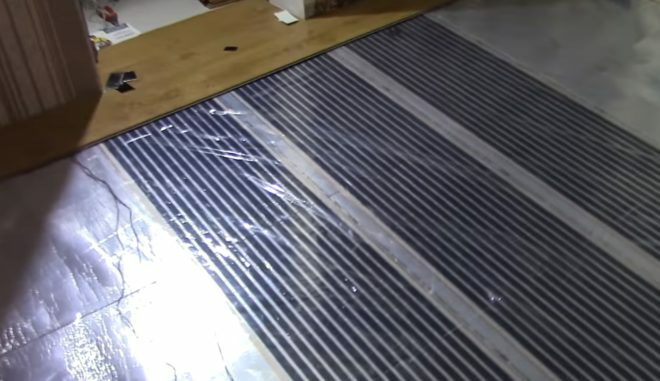
Image taken from https://www.youtube.com/watch? v = P_7v6Y4GcgY
Laying laminate
Before choosing a laminate for the kitchen, it is worth evaluating how flat the floor surface is. There is a cover with a snap lock and collapsible products. The latter are easier to lay. A floor level difference of up to 3 mm is allowed. Can be laid directly on concrete and glued to it.
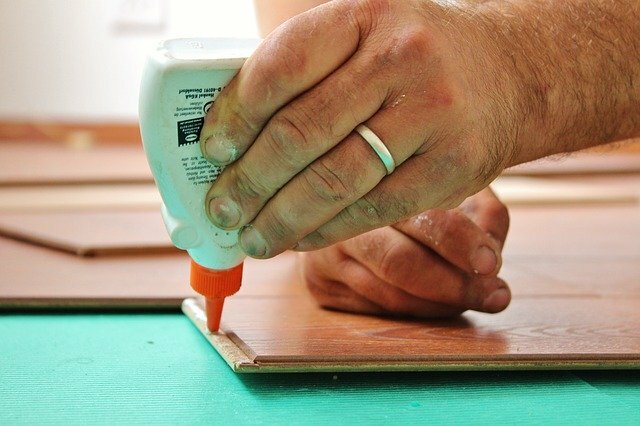
Products with a lock are laid on a leveled floor; you can use concrete pouring. To improve heat and sound insulation, a cork layer or polyethylene foam is placed under the floor. If laid without a backing, it will squeak.
When buying a laminate, you need to take with a small margin. Defective elements can be replaced at any time. The reserve is from 5% with sufficient experience of the master and a rectangular shape of the room, up to 15% with a diagonal arrangement of dies or a large number of corners and rounds in the room.
Work should be carried out taking into account the manufacturer's recommendations. Can be laid over linoleum, tiles, old wood flooring. It is better to place the planks longitudinally in the direction of the light from the window. Be sure to keep a distance of 1 to 2 cm from the wall as the laminate expands and contracts. a little, but still.
Care and maintenance tips
A moisture-resistant laminate in the kitchen will last a long time if it is properly looked after. It is better to wipe up spilled liquid immediately. If the laminate class is 32, the joints can be dried with a hairdryer to remove the accumulated liquid. It is better to process the joints between the lamellas periodically (once a season) with water-repellent mixtures (mastic). This will reduce the seepage of liquid between parts when it hits the floor.

Image taken from https://www.youtube.com/watch? v = NGK2EgQnvTU
When moving furniture, remember that sharp edges can leave marks on the floor. Use a wax crayon to match the floor to make scratches less noticeable.
If you buy a quality coating of the brands Meister, Gastilla, Egger, Tarkett, class 33 or 34, right assemble it, additionally protect the joints with a water-repellent varnish, for 10 - 20 years it will look like new. You can perform noise insulation, if necessary, put a warm floor, then it will be even more convenient and pleasant to use. The more expensive a product is, the more resistant it is to impacts, scratches, abrasion, and staining.
average rating 0 / 5. Number of ratings: 0
No ratings yet. Be the first to rate.
